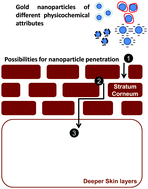Mechanism and determinants of nanoparticle penetration through human skin
Abstract
The ability of

* Corresponding authors
a
Pharmaceutical Nanotechnology, Saarland University, Saarbrücken, Germany
E-mail:
marc.schneider@mx.uni-saarland.de
Fax: +0049 681 302 4677
Tel: +0049 681 302 2438
b Department of Pharmaceutics, University of Alexandria, Alexandria, Egypt
c Structure Formation Group, Leibniz Institute for New Materials (INM), Saarbrücken, Germany
The ability of

 Please wait while we load your content...
Something went wrong. Try again?
Please wait while we load your content...
Something went wrong. Try again?
H. I. Labouta, L. K. El-Khordagui, T. Kraus and M. Schneider, Nanoscale, 2011, 3, 4989 DOI: 10.1039/C1NR11109D
To request permission to reproduce material from this article, please go to the Copyright Clearance Center request page.
If you are an author contributing to an RSC publication, you do not need to request permission provided correct acknowledgement is given.
If you are the author of this article, you do not need to request permission to reproduce figures and diagrams provided correct acknowledgement is given. If you want to reproduce the whole article in a third-party publication (excluding your thesis/dissertation for which permission is not required) please go to the Copyright Clearance Center request page.
Read more about how to correctly acknowledge RSC content.
 Fetching data from CrossRef.
Fetching data from CrossRef.
This may take some time to load.
Loading related content
